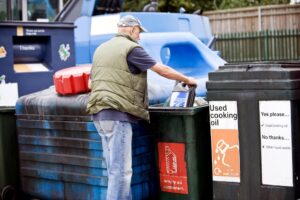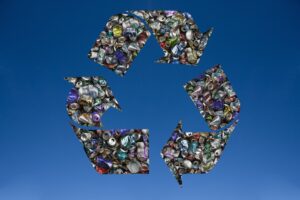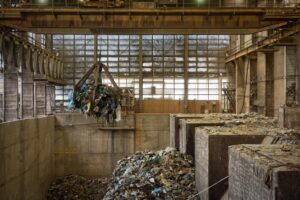Plastic is everywhere — wrapping our food, protecting medical supplies, insulating homes, and even forming the casings of the devices we use daily. It’s lightweight, durable, and versatile, which makes it hard to replace. But its slow decomposition and accumulation in landfills and oceans have created one of the greatest environmental challenges of our time.
By 2060, global plastic production is projected to nearly triple (OECD). Without meaningful change, the planet will drown in it. While some innovations promise to transform plastic into a resource, the reality is sobering: plastic will never be truly sustainable. At best, we can slow its harm while urgently accelerating the shift to better materials.
The Limits of Repurposing Plastic
For years, DIY hacks suggested bottle planters, bird feeders, or art projects as “eco-friendly” ways to repurpose plastic. But science now makes clear:
- Microplastics leach into soil and water when bottles, bags, or containers are exposed to sunlight, heat, and moisture.
- Craft-based reuses rarely extend lifespan meaningfully — they simply delay plastic’s trip to the landfill or incinerator.
- Repurposed plastic in contact with food, soil, or wildlife is often more harmful than helpful.
In short: plastic repurposing does not solve plastic pollution. At best, it buys time. At worst, it spreads microplastic contamination into new places — gardens, backyards, and ecosystems.
Safer Repurposing (When Recycling Isn’t an Option)
There are limited cases where repurposing can be less harmful:
- Enclosed insulation (plastic used as filler inside sealed walls).
- Eco-bricks (plastic waste sealed inside bottles and used as construction blocks).
- Non-food storage (organizing hardware, tools, or art supplies — not soil, plants, or edibles).
But these are stopgaps. The larger truth remains: the only real solution is to reduce production and consumption of plastic itself.
Recycling Plastic: Necessary but Limited
Recycling is critical, but it isn’t a silver bullet. Less than 10% of global plastic is recycled each year. Challenges include:
- Contamination: Food residue or mixed plastics reduce recyclability.
- Downcycling: Most recycled plastics are turned into lower-grade products, not closed-loop packaging.
- Economic limits: Virgin plastic is often cheaper to produce than recycled plastic.
Still, recycling saves energy and keeps plastic in circulation longer. Commonly recycled plastics include PET (bottles), HDPE (jugs), and PVC (pipes), though many others never make it through the system.
Innovation: Can Technology Make Plastic Sustainable?
Some innovations show promise, but none erase the fundamental problem of overproduction:
- Plastic Roads: Mixing shredded plastic into asphalt creates durable, longer-lasting roads, though long-term microplastic risks remain under study.
- Plastic Lumber: Recycled plastic extruded into boards for decks or fences. Strong and rot-resistant, but still sheds microplastics as it degrades.
- Eco-Bricks: Useful in regions without waste infrastructure, but they don’t eliminate plastic — they only lock it in place.
- 3D Printing: Repurposing waste plastic into filament for manufacturing. Valuable for small-scale reuse but not scalable to global waste levels.
- Pyrolysis (Plastic-to-Fuel): Converts waste to fuel, but still releases greenhouse gases when burned.
Innovation can help manage waste already in circulation. But it doesn’t change the root issue: we are making far too much plastic, far too quickly.
Challenges to Overcome
To move forward, society must face the systemic barriers:
- Infrastructure gaps: Many regions lack basic recycling or waste management.
- Low market demand: Recycled plastics are less profitable than virgin materials.
- Policy failure: Weak regulations allow plastic production to rise unchecked.
- Public misconception: “Recycling” is treated as a cure-all, creating a false sense of security.
What You Can Do (and What You Shouldn’t)
- Choose reusables first: Glass jars, stainless steel bottles, and cloth bags replace thousands of disposables.
- Avoid misleading repurposing: Don’t use plastic bottles for planters, feeders, or food-related projects.
- Recycle correctly: Rinse and sort only what your community accepts.
- Support alternatives: Choose compostable, reusable, or package-free goods.
- Advocate for systemic change: Push for bans on unnecessary single-use plastics and investment in true circular systems.
Final Thoughts
Plastic will never be the planet’s friend. At best, we can minimize its harm while working to replace it. Repurposing may feel creative, but many uses spread contamination rather than stopping it. Recycling helps, but it can’t keep up with runaway production.
The most powerful shift is away from the myth that plastic can be made “sustainable.” Instead, we must design a future where better materials replace it, waste is designed out of the system, and human choices ripple into healthier ecosystems.
Small actions matter — not because they make plastic sustainable, but because they signal that we’re ready to move beyond it.









Reader Interactions